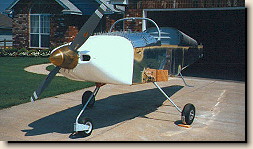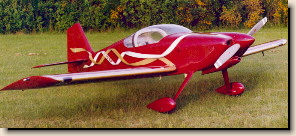|
Introduction
- Building an RV
RV Aircraft are low wing monoplanes of
traditional aluminum construction. In keeping with the light sport aircraft philosophy,
our prototypes were equipped with simple VFR instrumentation, a single comm radio, a Loran
or GPS, and a transponder. All were originally equipped with wood propellers which offer
excellent performance at moderate cost, along with light weight and smooth operation.
All designs incorporate two wing fuel tanks.
These are sealed, removable, portions of the leading edge, much like the Piper Cherokee or
Archer. Fuel from the tanks is routed through a selector valve in the cockpit to the
engine driven fuel pump. An electric fuel pump is installed in the system as a backup.
Control
linkages to the ailerons, elevators and flaps are
push-pull tubes for positive control and friction-free
operation. The rudder is controlled by cables. The
RV-4 and RV-8/8A are soloed from the front seat, but
elevator and aileron controls for the rear seat are
also provided. The RV-6/6A and RV-9A features full
dual controls, except passenger brakes which are optional.
Baggage space in the RV-4
consists of about 7 cubic feet in a compartment behind
the hinged seat back. Weight allowed is about 35 pounds,
depending on optional equipment and other loading
factors. The RV-4 has an optional front baggage area,
accessible from within the cockpit, that can carry
up to 15 pounds. The wide forward fuselage of the
RV-8/8A provides not only more instrument panel space,
cabin width and foot room than the RV-4, but also
allows a forward baggage compartment between the instrument
panel and the firewall. It holds about 4.75 cubic
feet, and is accessible through an outside door. The
traditional baggage compartment behind the rear seat
remains. By having two places for baggage, one forward
and one aft, the pilot has more loading options and
is better able to control the CG.
Baggage in the RV-6/6A is carried behind the
seats in a large 12-14 cubic foot bay with an average capacity of about 65 pounds with two
170 lb people in the seats.
All RV models feature short, low aspect ratio,
constant chord wings. This wing planform offers light weight, easy construction, and
favorable stall characteristics. The wide chord maximizes the permissible CG range. It
also provides generous wing area and low wing loading even in a wing of short span.
Because of this low wing loading, climb and altitude performance are unusually good for an
airplane of such short span. RVs use the proven NACA 230 series airfoil. These are
turbulent flow airfoils with very low pitching moments. They do not require perfectly
smooth surfaces to achieve good performance, so they remain almost unaffected by bugs and
rain. The low pitching moment allows cruise trim drag to be kept to a minimum.
Aluminum
aircraft structures offer the homebuilder many advantages.
Unlike many of the bonding or laminating processes
used in wood or fiberglass structures, riveting is not temperature sensitive. Aluminum is
non-allergenic and should cause the builder no health
problems, other than an occasional case of being "sick
and tired" of working with it. Its low maintenance
and structural integrity has been verified by tens
of thousands of aluminum aircraft, light and heavy,
built in the last 50 years.
riveting is not temperature sensitive. Aluminum is
non-allergenic and should cause the builder no health
problems, other than an occasional case of being "sick
and tired" of working with it. Its low maintenance
and structural integrity has been verified by tens
of thousands of aluminum aircraft, light and heavy,
built in the last 50 years.
RV structures are "monocoque" or
"stressed skin" designs. This means that the skins themselves provide much of
the airframe’s strength. The primary bending loads of the wing are carried by the
single main spar. Wing torsional and drag loads are carried by the wing skins and rear
spar. The same is true of the tail surfaces. The fuselage skins, whose shape is maintained
by formed aluminum bulkheads, provides torsional and bending strength. Aluminum angle
longerons in the fuselage provide stiffening for the skin and greater strength at
localized points of attachment.
You might be surprised to learn that aluminum
aircraft structures are as light or lighter than composite structures. One reason many
composite homebuilt designs are lighter than the aluminum RVs is simply that they are
smaller, particularly in wing area. The RVs’ low landing speeds require larger wings,
along with longer fuselages and larger tail surfaces. If built from conventional
composites, they would weigh more than aluminum. Some advanced, exotic, composites are
lighter than aluminum, but they are usually much more expensive. If you analyze the
composite kitplanes now available, we feel you will agree that their light weight is a
result of small wings -- which equate to high landing speeds, longer field lengths and
less utility.
The various structural members of the RV are
joined by rivets. Both standard solid ("AN") and blind or "pop" rivets
are used. The solid rivets are used predominantly, while blind rivets are used only in
secondary structural areas or where access is limited. The solid rivets are stronger, much
less expensive and provide a better finish, but they do take a bit more skill and
equipment to use. A pneumatic rivet gun and accessories are required. While blind riveting
might seem easier at first, the skills of solid riveting are not difficult to learn.
The needs of the homebuilder were one of our
foremost concerns when designing the RV airframe structures. All materials used in RVs are
common to production lightplanes and while they are all of aircraft quality, many are
available from non-aircraft industrial suppliers.
To minimize cost, we avoided using exotic
extrusions or parts requiring intricate machining. Some parts, the engine/gearleg mount
for example, by their nature require skilled and intricate fabrication processes. These
parts we supply as finished units; part of the kit.
The time required to complete an RV will
vary greatly with the work habits of the builder. We estimate about 2000
person hours for an
RV-4 or RV-6/6A. Builders choosing the QuickBuild Kit available for the RV-6/6A will save
around 1000 hours. The RV-8/8A kit, which incorporates developments based on years of
experience, will probably take 1700-1800 hours.
These estimates are based
on airplanes built from our kits and presuppose a
basic airplane, inside and out. Installing complex
avionics, instruments and interiors can add hundreds
of hours to the project. It is possible to build from
raw material, but the  few
who have tried this have reported that they ended
up spending 500-1000 additional hours and nearly the
same money as if they had used the kits. few
who have tried this have reported that they ended
up spending 500-1000 additional hours and nearly the
same money as if they had used the kits.
Cost to build can also vary widely. Assuming the
builder is a wise shopper, uses one of our standard kits, buys a mid-price used engine and
equips his airplane with a simple interior and VFR instrumentation, the ready to fly cost
of a basic RV should be about $30,000.
Typically, builders want something more than a
"no-frills" airplane, and a representative airplane averages between $40,000 -
$50,000. Some elaborately equipped airplanes cost even more.
| Cockpit/Cabin
Considerations |
The most important part of the airplane is
its passengers. Their safety and comfort are paramount. Since forward visibility and
safety are close relatives, upright rather than supine seating was chosen. We felt that it
would be illogical to lay the passengers down and then have them try to see forward over
the engine. Leg room, shoulder room and head room are the important cabin dimensions. RV
cockpits are quite roomy and accommodate pilots and passengers up to 6’ 4’’
tall -- even taller in the RV-8/8A. Minor modifications are possible during construction
that allow even taller people to fit.
Operational safety and crash
survivability, often overlooked in homebuilts, are a primary concern to everyone at
Van’s. First, to limit the possibility of accidents, RVs have more than adequate
controllability for all anticipated flight and ground operations, gentle stall
characteristics, and superb visibility.
In the event of an unavoidable crash landing,
(engine failure over rough terrain, for instance) their low landing speed should be a real
lifesaver. A crash at 50 mph is 70% more survivable than one at 65 mph. This, along with
the thick skinned cockpit with multiple longerons and sturdy roll bar, should permit you
to walk away from, or at least survive, almost any controlled landing.
Easy maintenance was another prime
consideration in the design of RVs. Controls, linkages and fittings are easy to install
and service. Other than the engine cowl, only a few inspection plates and fairings need to
be removed to inspect all bellcranks, hingepoints and the like. The straightforward,
simple, control system has only a few points that require service. When primed and
protected as recommended, the aluminum airframe resists corrosion well; with proper
storage and maintenance, it is essentially a "life-time" structure.
The RV structures are designed and built so they
can be dismantled when necessary. The wings are constructed in two separate panels, and
their main spars are bolted together at the fuselage. All of the tail surfaces are also
removable. This permits easy transport to the airport for initial assembly, or later
disassembly for major maintenance, etc. Though the wings are removable, this task takes
several hours. The RVs’ wings are not designed for quick removal for regular
trailering and home storage.
|